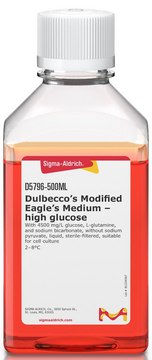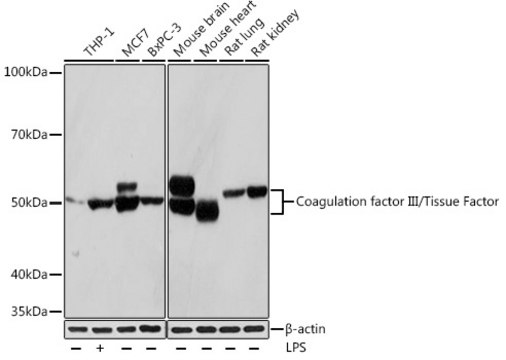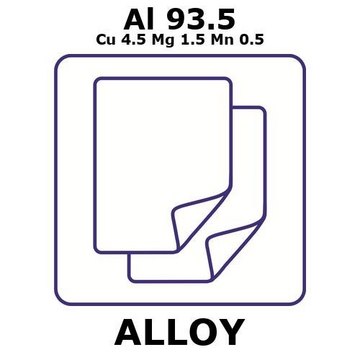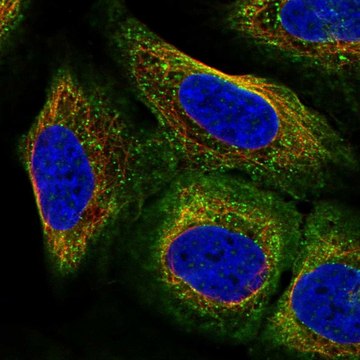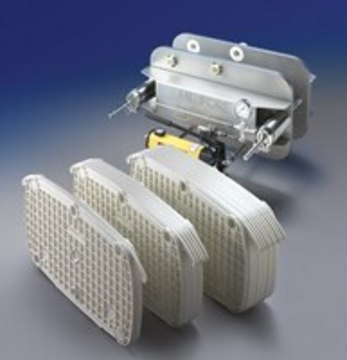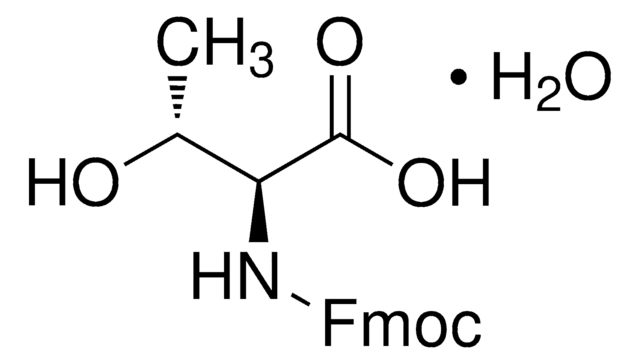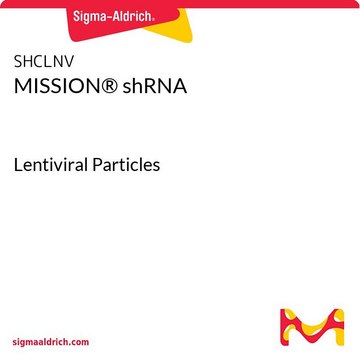推荐产品
生物来源
mouse
质量水平
抗体形式
purified antibody
抗体产品类型
primary antibodies
克隆
HTF-1, monoclonal
分子量
calculated mol wt 33 kDa
observed mol wt ~42-48 kDa
纯化方式
using protein G
种属反应性
human, bovine
包装
antibody small pack of 100
技术
ELISA: suitable
dot blot: suitable
flow cytometry: suitable
immunohistochemistry: suitable
inhibition assay: suitable
western blot: suitable
同位素/亚型
IgG1κ
表位序列
Unknown
Protein ID登记号
UniProt登记号
储存温度
-10 to -25°C
基因信息
human ... F3(2152)
特异性
Clone HTF-1 is a mouse monoclonal antibody that specifically detects Tissue Factor/CD142 protein.
免疫原
Full length native (purified) human Tissue Factor.
应用
Immunofluorescence Microscopy
Tissue factor: Identification and characterization of cell types in human placentae. (Faulk, W.P., C.A. Labarrere, and S.D. Carson. (1990). Blood 76:86-96).
Immunofluorescent studies of tissue factor on U87MG cells: Evidence for non-uniform distribution. Carson, S.D., and S.J. Pirruccello. (1993). Blood Coagulation and Fibrinolysis 4:911-920).
Flow Cytometry
Tissue factor antigen and activity are not expressed on the surface of intact cells isolated from an acute promyelocytic leukemia patient. (Carson, S.D., S.J. Pirruccello, and W.D. Haire. (1990). Thrombos. Res. 59:159-170).
Immunohistochemistry
Participation of cell-mediated immunity in the deposition of fibrin in glomerulonephritis. (Neale, T.J., P.G. Tipping, S.D. Carson, and S.R. Holdsworth. (1988). Lancet, No. 8606, 2:421-424).
Tissue factor antigen in senile plaques of Alzheimer′s disease. (McComb, R.D., K.A. Miller, and S.D. Carson. (1991). Am. J. Path. 139:491-494).
Immunoaffinity purification of the tissue factor protein
An inhibitory monoclonal antibody against human tissue factor. (Carson, S.D., S.E. Ross, R. Bach, and A. Guha. (1987). Blood 70:490-493).
Tissue factor: Identification and characterization of cell types in human placentae. (Faulk, W.P., C.A. Labarrere, and S.D. Carson. (1990). Blood 76:86-96).
Immunofluorescent studies of tissue factor on U87MG cells: Evidence for non-uniform distribution. Carson, S.D., and S.J. Pirruccello. (1993). Blood Coagulation and Fibrinolysis 4:911-920).
Flow Cytometry
Tissue factor antigen and activity are not expressed on the surface of intact cells isolated from an acute promyelocytic leukemia patient. (Carson, S.D., S.J. Pirruccello, and W.D. Haire. (1990). Thrombos. Res. 59:159-170).
Immunohistochemistry
Participation of cell-mediated immunity in the deposition of fibrin in glomerulonephritis. (Neale, T.J., P.G. Tipping, S.D. Carson, and S.R. Holdsworth. (1988). Lancet, No. 8606, 2:421-424).
Tissue factor antigen in senile plaques of Alzheimer′s disease. (McComb, R.D., K.A. Miller, and S.D. Carson. (1991). Am. J. Path. 139:491-494).
Immunoaffinity purification of the tissue factor protein
An inhibitory monoclonal antibody against human tissue factor. (Carson, S.D., S.E. Ross, R. Bach, and A. Guha. (1987). Blood 70:490-493).
Quality Control Testing
Evaluated by Western Blotting in A-431cell lysate.
Western Blotting Analysis: A 1:500 dilution of this antibody detected Tissue Factor/CD142 in A-431 cell lysate.
Tested Applications
ELISA Analysis: A representative lot detected Tissue Factor/CD142 in ELISA applications (Carson, S.D., et al. (1987). Blood. 70(2):490-3).
Western Blotting Analysis: A representative lot detected Tissue Factor/CD142 in Western Blotting applications (Carson, S.D., et al. (1987). Blood. 70(2):490-3). .
Dot Blot: A representative lot detected Tissue Factor/CD142 in Dot Blot applications (Carson, S.D., et al. (1987). Blood. 70(2):490-3).
Inhibition Assay: A representative lot detected Tissue Factor/CD142 in Inhibition applications (Carson, S.D., et al. (1987). Blood. 70(2):490-3).
Note: Actual optimal working dilutions must be determined by end user as specimens, and experimental conditions may vary with the end user.
Evaluated by Western Blotting in A-431cell lysate.
Western Blotting Analysis: A 1:500 dilution of this antibody detected Tissue Factor/CD142 in A-431 cell lysate.
Tested Applications
ELISA Analysis: A representative lot detected Tissue Factor/CD142 in ELISA applications (Carson, S.D., et al. (1987). Blood. 70(2):490-3).
Western Blotting Analysis: A representative lot detected Tissue Factor/CD142 in Western Blotting applications (Carson, S.D., et al. (1987). Blood. 70(2):490-3). .
Dot Blot: A representative lot detected Tissue Factor/CD142 in Dot Blot applications (Carson, S.D., et al. (1987). Blood. 70(2):490-3).
Inhibition Assay: A representative lot detected Tissue Factor/CD142 in Inhibition applications (Carson, S.D., et al. (1987). Blood. 70(2):490-3).
Note: Actual optimal working dilutions must be determined by end user as specimens, and experimental conditions may vary with the end user.
目标描述
Tissue factor (UniProt: P13726; also known as TF, Coagulation factor III, Thromboplastin, CD142) is encoded by the F3 gene (Gene ID: 2152) in human. Tissue factor (TF) is an integral membrane protein that serves as a high-affinity receptor and cofactor for factor VII/VIIa. It is expressed on perivascular cells and epithelial cells at organ and body surfaces where it forms a hemostatic barrier. It is also reported to provide hemostatic protection to brain, lung, and heart. In normal healthy individuals, levels of TF are very low. Cell-surface levels of TF do not display any directly correlation with its procoagulant activity indicating that TF exists on the cell surface as dormant (encrypted) and active (de-encrypted) form. This allows for a rapid hemostatic response without a need for transcriptional upregulation of the F3 gene. TF normally exists in a partially encrypted state and its de-encryption on circulating monocytes, platelets or endothelial cells by inflammatory mediators can lead to thrombosis. It initiates blood coagulation by forming a complex with circulating factor VII or VIIa and this complex activates factor IX and X by specific, limited proteolysis. TF expression by nonvascular cells plays an essential role in homeostasis; however, TF expression by vascular cells can induce life-threatening intravascular thrombosis in various diseases, such as sepsis, cancer, and atherosclerosis. Inhibition of TF-Factor VIIa activity is shown to reduce coagulation and mortality in animal models of sepsis. Many cancer cells express large amounts of TF, which contributes to tumor angiogenesis and growth. Cancer cells can release TF-positive microparticles into the circulation that can trigger venous thromboembolism. TF on circulating tumor cells can also coat cells with fibrin that traps them within the microvasculature and promote hematogenous metastasis. (Ref.: Carson, S.D., et al. (1987). Blood. 70(2):490-3; Caldwell, JA., et al. (2010). Lab. Invest. 90; 953-962; Kasthuri, RS., et al. (2009). J. Clin. Oncol. 27(29); 4834-4838; Mackman, N. (2004).
外形
Purified mouse monoclonal antibody IgG1 in PBS without azide.
重悬
0.5 mg/mL. Please refer to guidance on suggested starting dilutions and/or titers per application and sample type.
储存及稳定性
Store at -10°C to -25°C. Handling Recommendations: Upon receipt and prior to removing the cap, centrifuge the vial and gently mix the solution. Aliquot into microcentrifuge tubes and store at -20°C. Avoid repeated freeze/thaw cycles, which may damage IgG and affect product performance.
其他说明
Concentration: Please refer to the Certificate of Analysis for the lot-specific concentration.
免责声明
Unless otherwise stated in our catalog or other company documentation accompanying the product(s), our products are intended for research use only and are not to be used for any other purpose, which includes but is not limited to, unauthorized commercial uses, in vitro diagnostic uses, ex vivo or in vivo therapeutic uses or any type of consumption or application to humans or animals.
未找到合适的产品?
试试我们的产品选型工具.
储存分类代码
12 - Non Combustible Liquids
WGK
WGK 2
闪点(°F)
Not applicable
闪点(°C)
Not applicable
法规信息
新产品
S D Carson et al.
Blood coagulation & fibrinolysis : an international journal in haemostasis and thrombosis, 4(6), 911-920 (1993-12-01)
U87MG cells (human glioblastoma) express tissue factor and shed membrane-derived vesicles enriched in procoagulant activity. Tissue factor antigen has been studied by flow cytometry, immunofluorescent microscopy and Western blotting. Flow cytometric analysis utilized monoclonal antibodies recognizing the tissue factor extracellular
T J Neale et al.
Lancet (London, England), 2(8608), 421-424 (1988-08-20)
Fibrin deposition is prominent in delayed-type hypersensitivity (DTH) reactions and is initiated by antigen-specific, T-lymphocyte-directed macrophage expression of human tissue factor (HTF). To examine the role of DTH in glomerular fibrin deposition, 10 fibrin-positive and 24 fibrin-negative biopsy specimens from
R D McComb et al.
The American journal of pathology, 139(3), 491-494 (1991-09-01)
Tissue factor (tissue thromboplastin) is the primary initiator of the extrinsic coagulation pathway, triggering a proteolytic cascade when exposed to circulating coagulation factors. In this study, the distribution of tissue factor was examined immunohistochemically in Alzheimer's disease (AD) and control
S D Carson et al.
Blood, 70(2), 490-493 (1987-08-01)
We obtained a hybridoma using immune spleen cells from a mouse injected with human brain tissue factor that had been purified on a factor VII-agarose affinity column. This monoclonal IgG1, HTF1-7B8, inhibits tissue factor procoagulant activity. The concentration of HTF1-7B8
S D Carson et al.
Thrombosis research, 59(1), 159-170 (1990-07-01)
Tissue factor activity and antigen were measured in promyelocytes freshly isolated from a patient with acute promyelocytic leukemia (APL), FAB M3. Determination of functional activity revealed that physically disrupted cells expressed considerable tissue factor of which less than two percent
我们的科学家团队拥有各种研究领域经验,包括生命科学、材料科学、化学合成、色谱、分析及许多其他领域.
联系技术服务部门